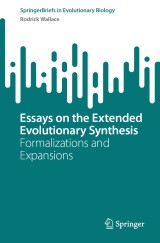Details

Essays on the Extended Evolutionary Synthesis
Formalizations and ExpansionsSpringerBriefs in Evolutionary Biology
|
53,49 € |
|
| Verlag: | Springer |
| Format: | |
| Veröffentl.: | 18.05.2023 |
| ISBN/EAN: | 9783031298790 |
| Sprache: | englisch |
Dieses eBook enthält ein Wasserzeichen.
Beschreibungen
From the ‘punctuated equilibrium' of Eldrege and Gould, through Lewontin's ‘triple helix' and the various visions and revisions of the Extended Evolutionary Synthesis (EES) of Laland and others, both data and theory have demanded an opening-up of the 1950's Evolutionary Synthesis that so firmly wedded evolutionary theory to the mathematics of gene frequency analysis. It can, however, be argued that a single deep and comprehensive mathematical theory may simply not be possible for the almost infinite varieties of evolutionary process active at and across the full range of scales of biological, social, institutional, and cultural phenomena. Indeed, the case history of 'meme theory' should have raised a red flag that narrow gene-centered models of evolutionary process may indeed have serious limitations. What is attempted here is less grand, but still broader than a gene-centered analysis. Following the instruction of Maturana and Varela that all living systems are cognitive, in a certainsense, and that living as a process is a process of cognition, the asymptotic limit theorems of information and control theories that bound all cognition provide a basis for constructing an only modestly deep but wider-ranging series of probability models that might be converted into useful statistical tools for the analysis of observational and experimental data related to evolutionary process. The line of argument in this series of interrelated essays proves to be surprisingly direct.
1 On the majortransitions.- 1.1 Introduction.- 1.2 Symmetry and symmetry-breaking.- 1.3 Resources.- 1.4 Cognition in non ergodic systems.- 1.5 Theprebiotic`bigbang'.- 1.6 Biological`recombination transparency'.- 1.7 A simple application.- 1.8 Specialization and cooperation: multiple workspaces.- 1.9 Discussion.- 1.10 Mathematical Appendix.- 1.11 References.- 2 On the Extended Evolutionary Synthesis.- 2.1 Introduction.- 2.2 First notions.- 2.3 The basic theory.- 2.4 Examples.- 2.5 More theory:selection pressureas shadowprice.- 2.6 Extending the models.- 2.7 Discussion.- 2.8 Mathematical Appendix.- 2.9 References.- 3O On regulation.- 3.1 Introduction.- 3.2 Theory.- 3.3 Applications.- 3.4 Discussion.- 3.5 Mathematical Appendix.- 3.6 References.- 4 Punctuated regulation as an evolutionary mechanism.- 4.1 Introduction.- 4.2 Fisher Zeros reconsidered.- 4.3 Extinction I:Simple noise-induced transitions.- 4.4 Extinction II: More complicatednoise-induced transitions.- 4.5 Extinction III: Environmental shadow price.- 4.6 Discussion.- 4.7 Mathematical Appendix.- 4.8 References.- 5 Institutional dynamics under selection pressure and uncertainty.- 5.1 Introduction.- 5.2 A Rate Distortion Theorem model of control.- 5.3 Selection pressure dynamics.- 5.4 Destabilization by delay.- 5.5 Extending the Data Rate Theorem.- 5.6 Moving on.- 5.7 Reconsideringcognition\textit{AnSich.- 5.8 Changingtheviewpoint.- 5.9 Discussion.- 5. References.- 6O n`Speciation':Fragmentsizeininformationsystemphasetransitions.- 6.1 Introduction.- 6.2`Simple'phasetransition.- 6.3 Phasetransitionsinnetworksofinformation-exchangemodules.- 6.4 Discussion.- 6.5 MathematicalAppendix:`Biological'renormalizations.- 6.6 References.- 7 Adaptingcognitionmodelstobiomolecularcondensatedynamics.- 7.1 Introduction.- 7.2 Resources.- 7.3 Cognition.- 7.4 PhasetransitionsI:Fisherzeros.- 7.5 Cognitive`reactionrate'.- 7.6 PhasetransitionsII:Signaltransductionandnoise.- 7.7 Discussion.- 7.8 MathematicalAppendix:Groupoids.- 7.9 References.- 8 EvolutionaryExaptation:Sharedinterbrainactivityinsocialcommunication.- 8.1 Introduction.- 8.2 Correlation.- 8.3 Cognition.- 8.4 Dynamics.- 8.5 Cognitionrate.- 8.6 Anexample.- 8.7 Cooperation:Multipleworkspaces.- 8.8 Networktopologyisimportant.- 8.9 Timeandresourceconstraintsareimportant.- 8.10 Furthertheoreticaldevelopment.- 8.11 Discussion.- 8.12 MathematicalAppendix.- 8.13 References.- 9 Afterward.
<p><b>Rodrick Wallace</b> is a research scientist in the Division of Epidemiology at the New York State Psychiatric Institute, affiliated with Columbia University’s Department of Psychiatry. He has an undergraduate degree in mathematics and a PhD in physics from Columbia, and completed postdoctoral training in the epidemiology of mental disorders at Rutgers. He worked as a public interest lobbyist, including two decades conducting empirical studies of fire service deployment, and subsequently received an Investigator Award in Health Policy Research from the Robert Wood Johnson Foundation. In addition to material on public health and public policy, he has published peer reviewed studies modeling evolutionary process and heterodox economics, as well as many quantitative analyses of institutional and machine cognition. He publishes in the military science literature, and in 2019 received one of the UK MoD RUSI Trench Gascoigne Essay Awards.<br></p><p></p>
From the ‘punctuated equilibrium' of Eldrege and Gould, through Lewontin's ‘triple helix' and the various visions and revisions of the Extended Evolutionary Synthesis (EES) of Laland and others, both data and theory have demanded an opening-up of the 1950's Evolutionary Synthesis that so firmly wedded evolutionary theory to the mathematics of gene frequency analysis. It can, however, be argued that a single deep and comprehensive mathematical theory may simply not be possible for the almost infinite varieties of evolutionary process active at and across the full range of scales of biological, social, institutional, and cultural phenomena. Indeed, the case history of 'meme theory' should have raised a red flag that narrow gene-centered models of evolutionary process may indeed have serious limitations. What is attempted here is less grand, but still broader than a gene-centered analysis. Following the instruction of Maturana and Varela that all living systems are cognitive, in a certainsense, and that living as a process is a process of cognition, the asymptotic limit theorems of information and control theories that bound all cognition provide a basis for constructing an only modestly deep but wider-ranging series of probability models that might be converted into useful statistical tools for the analysis of observational and experimental data related to evolutionary process. The line of argument in this series of interrelated essays proves to be surprisingly direct.
Provides comprehensive formal foundation for the Extended Evolutionary Synthesis Examines the evolutionary exaptation of crosstalk between physiological and other information processes Serves as a roadmap for development of new statistical tools
Diese Produkte könnten Sie auch interessieren:

The Neural Crest and Neural Crest Cells in Vertebrate Development and Evolution

von: Brian K. Hall

149,79 €















